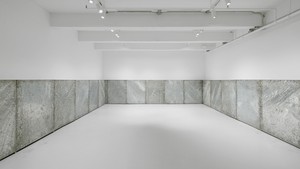
Donald Judd: Untitled: 1970
In this video, Flavin Judd, the artist’s son and artistic director of Judd Foundation, discusses a historic large-scale work by his father from 1970, ahead of its presentation at Art Basel Unlimited 2024.
At Art Basel Unlimited 2024, Gagosian is presenting a rare, large-format work by Donald Judd, which until now has never before been shown outside of the United States.
Since its creation in 1970, the piece has only been exhibited five times before, and only twice in its original U-shaped configuration of galvanized iron panels. In line with Unlimited’s focus on championing monumental and trailblazing projects, this important work also marks Judd’s development of immersive, architecturally scaled works that produce an equally visceral and intellectual experience for the viewer.

Untitled, 1970
Hot-dipped galvanized iron, in 22 units
18 units, each: 60 × 48 × ¼ inches (152.4 × 122 × 0.6 cm)
2 units, each: 60 × 41 × ¼ inches (152.4 × 104 × 0.6 cm)
1 unit: 60 × 43 × ¼ inches (152.4 × 33 × 0.6 cm)
1 unit: 60 × 4 ¾ × ¼ inches (152.4 × 33 × 0.6 cm)
Overall dimensions variable

On April 11, 1970, Leo Castelli opened Donald Judd’s third exhibition at his influential uptown gallery on East 77th Street in New York. The indisputable highlight of the show was a new work that Judd created specifically with the gallery’s architectural space in mind. A set of eighteen luminous hot-dipped galvanized iron panels extended across three contiguous walls in a U-shaped configuration, engulfing the spectator in a profound experience centered on the relationships between material, space, and color—key concerns that preoccupied Judd throughout his lifetime.

Exhibition poster for Don Judd at Leo Castelli Gallery, New York, 1970

Installation view, Don Judd, Leo Castelli Gallery, 4 East 77th Street, New York, April 11–May 9, 1970. Artwork © Judd Foundation/Artists Rights Society (ARS), New York. Photo: Rudy Burckhardt, courtesy Castelli Gallery © 2024 Estate of Rudy Burckhardt/Artists Rights Society (ARS), New York
This work—which sits directly on the floor exactly eight inches away from the wall—exemplifies Judd’s profound achievement in transforming a given environment through his complex aesthetic rigor. While the spatial requirements for its initial installation at Castelli determined the number of panels that Judd originally created, the piece is site-relational and can be adapted to fit the location in which it is installed, and configured as either a straight line or a U shape. A total of twenty-two panels are available for this work; while certain parameters are set, such as the distance of the panels from the wall, the number of panels used for the installation is variable and dependent on the spatial requirements of a particular site.
This piece is a good way to see the radicality of Don’s work. This is 1970—it’s really radical for the time and, if you look around, pretty radical still.
Flavin Judd discusses untitled (1970). Artwork © Judd Foundation/Artists Rights Society (ARS), New York. Video: Pushpin Films
At Art Basel Unlimited, the work is installed nearly identically to how it was shown in the 1970 Leo Castelli show; six panels appear on opposing walls, with five running continuously between these sides. This U-shaped configuration offers a striking symmetry, as viewers can be immersed in the piece to greater or lesser degrees of engagement. The nuances of the material—hot-dipped galvanized iron fabricated by the Bernstein Brothers Sheet Metal Specialties—demonstrate infinite variance; the work shimmers as one moves through the space, captivating the eye and inviting closer reflection. While certainly Judd disavowed the presence of his artistic “hand,” the complexities of the material created through the industrial process of galvanization results in a gorgeously multifaceted surface composed of individual zinc crystals, which has notably been described as “electrochemically replicat[ing] Pollock’s biomechanical process.”

This work has an extraordinary exhibition history, one that contributes to the piece’s historical significance. Following the Castelli show, it was included in Judd’s noteworthy solo exhibition at the Pasadena Art Museum in May of the following year. Here, it was necessary to modify the number of panels from those used previously due to the respective spatial differences and the introduction of a curved wall at the museum. The work was ultimately installed in Pasadena as fourteen panels set in a straight line, while maintaining the eight-inch projection. The number of available panels to be used, as well as the possibilities for certain modifications to the panels in order to accomodate spatial considerations, communicates the potential for variability in the work’s installation on both practical and conceptual levels. The work was not exhibited again until 1988, when it was prominently included in the artist’s major survey exhibition at the Whitney Museum of American Art in New York featuring another straight-line configuration.
While the straight-line installation offers an opportunity to place the work along a single wall, using the outmost spatial corners as points of demarcation, the U-shaped installation provides an elegant sense of compositional order that heightens the work’s key features. The continuation of the piece as it wraps onto adjacent walls emphasizes the material’s reflective sheen, as light bounces between nearby panels and creates an immersive effect. David Raskin has referred to works like this as “constructions of place,” and the work undeniably heightens the viewer’s attention to their surroundings. The scale of the piece, reaching precisely five feet in height, allows for the observation of the work’s projection from the wall from over the top of the panels, while the work’s lateral edges are flush with the wall. This creates a fascinating juxtaposition between visual penetration and impermeability, one that is the essence of volumetric considerations of space.
Judd’s interest in creating a work that engages architectural space can be contextualized within both recent personal and art historical events that occurred around 1970. In late 1969, Judd moved with his young family into 101 Spring Street in New York’s SoHo neighborhood, where he maintained a residence and studio for the rest of his life. This shift in location corresponded with a greater emphasis on spatial environments found in Judd’s work; he began making pieces that incorporated the surrounding architecture in which a given piece is installed—a concept that would be further explored in the present work.

Installation view, Donald Judd, Whitney Museum of American Art, New York, October 20–December 31, 1988, featuring untitled (1970) in a straight-line installation, eight inches in front of wall, between two adjacent side walls. Artwork © Judd Foundation/Artists Rights Society (ARS), New York. Photo: Geoffrey Clements, courtesy Whitney Museum of American Art

Regarding the U-shaped installation of the work at Art Basel Unlimited, Judd’s emphasis on three visual planes might also connect to the artist’s earlier creation of his first-ever wraparound stack (DSS 187) in 1969, which featured green plexiglass on each unit’s front and side panels, adopting a similar structure. While Judd had created works that considered the environment to determine the number of units and the installation format as early as 1966, the present work was one of his first creations that could span multiple walls, indicating an increased focus on spatial environments that exceeded the artist’s previous output. This level of scale and form became a later preoccupation for Judd, appearing in a 1974 installation at the Portland Center for the Visual Arts in Oregon, as well as in the prominent inner U-shaped adobe wall at the Block in Marfa, Texas.

Donald Judd, untitled, 1974, plywood, temporary installation at Portland Center for the Visual Arts, Oregon, November 2–December 1, 1974. Artwork © Judd Foundation/Artists Rights Society (ARS), New York

Donald Judd, untitled, 1976–85, adobe bricks and cement, La Mansana de Chinati/The Block, Judd Foundation, Marfa, Texas. Artwork © Judd Foundation/Artists Rights Society (ARS), New York. Photo: Alex Marks
Just as this work features a U-shaped configuration of panels set away from the surrounding walls of the exhibition space, so, too, was the U-shaped inner wall at Marfa enclosed by a perimeter wall by Judd in 1985. In writing about this addition, Judd states: “The two walls and two areas, one sloped and the other level, make a work, I suppose, both art and architecture, although usually the distinction is important.” Certainly, in the present work seen at Art Basel Unlimited, this distinction is paramount—in many ways encapsulating the very essence of art’s ability to transform lived experience and indeed, the world around us.


In this video, Flavin Judd, the artist’s son and artistic director of Judd Foundation, discusses a historic large-scale work by his father from 1970, ahead of its presentation at Art Basel Unlimited 2024.
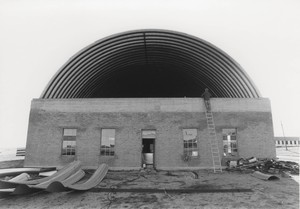
Julian Rose explores the question: what does it mean for an artist to make architecture? Delving into the archives of Donald Judd, he examines three architectural projects by the artist. Here, in the first installment of a two-part essay, he begins with an invitation in Bregenz, Austria, in the early 1990s, before turning to an earlier project, in Marfa, Texas, begun in 1979.

In this second installment of a two-part essay, Julian Rose continues his exploration of Donald Judd’s engagement with architecture. Here, he examines the artist’s proposals for projects in Bregenz, Austria, and in Basel, arguing that Judd’s approach to shaping space provides a model for contemporary architectural production.
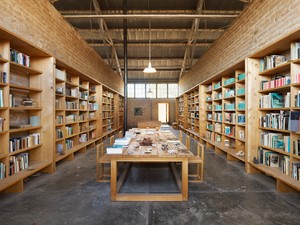
Richard Shiff speaks with Caitlin Murray, director of archives and programs at Judd Foundation, about the archive of Donald Judd, how to approach materials that occupy the gray area between document and art, and some of the considerations unique to stewarding an archive housed within and adjacent to spaces conceived by the artist.
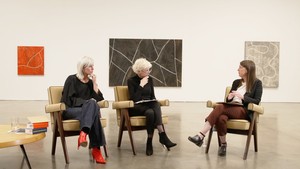
Art historian Eileen Costello and Yale School of Art professor Marta Kuzma discuss Donald Judd’s two-dimensional work and how the lessons he learned from the innovations of Abstract Expressionist and Color Field paintings permeate his entire body of work. Their conversation is moderated by Caitlin Murray, director of archives and programs at Judd Foundation.

Peter Ballantine, Donald Judd’s longtime fabricator of plywood works, and Martha Buskirk, professor of art history and criticism at Montserrat College of Art in Beverly, Massachusetts, discuss the development, production, and history of the largest plywood construction Judd ever made, an untitled work from 1980.
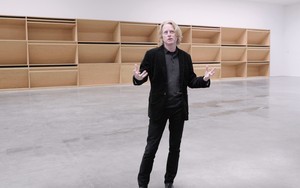
In this video, Flavin Judd, the artist’s son and artistic director of Judd Foundation, leads a walkthrough of the exhibition Donald Judd: Artwork: 1980 at Gagosian, West 21st Street, New York. Flavin connects the work to the concurrent retrospective at the Museum of Modern Art, New York, and the permanent installations in Marfa, Texas, highlighting how it fits within Judd’s oeuvre.
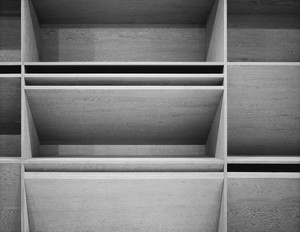
Flavin Judd, the artist’s son and artistic director of Judd Foundation, speaks with Kara Vander Weg about the recent installation of the sculptor’s eighty-foot-long plywood work from 1980 at Gagosian, New York.

The Fall 2022 issue of Gagosian Quarterly is now available, featuring Jordan Wolfson’s House with Face (2017) on its cover.